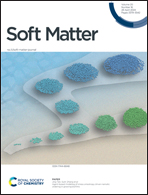Can self-propelled objects escape from compression stimulation?†
Abstract
We studied circular papers impregnated with camphor (CPs) and CPs with magnets (MCPs) as self-propelled objects floating on water under the compression of the water surface as an inanimate system for evacuation in an emergency. Two water chambers—Cin and Cout—were connected via a plastic gate, and eight CPs or eight MCPs were placed on Cin. We monitored the movement of the CPs or MCPs from Cin to Cout when the gate was opened and the area of Cin (Ain) was decreased using a barrier. When Ain was large, CPs moved stochastically from Cin to Cout while exhibiting random motion. The escape probability from Cin to Cout (P) at time t = 20 s increased with a decrease in Ain, and the rate of increase in P increased depending on the width of the gate (Wg). By contrast, clustering was observed for MCPs. Consequently, P of MCPs was lower than that of CPs. The difference in the surface tension between Cin and Cout (Δγ) increased with a decrease in Ain. P is discussed in relation to Δγ as the driving force for emergencies and the repulsive forces between CPs or attractive forces between MCPs. These results suggest that the repulsive force enhances the self-propulsion of objects towards the gate, that is, as a result, higher values of P are obtained.



 Please wait while we load your content...
Please wait while we load your content...